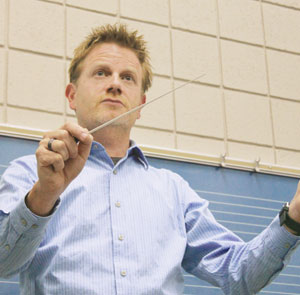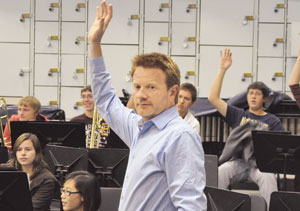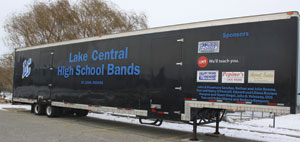
When Chris Harmon arrived at Lake Central High School (St. John, Indiana) 13 years ago, he had earned two master’s degrees and taught for three years at another Indiana high school. Since then he has built the program up so that there are 275 students in the band program, with three concert bands, two jazz ensembles, and the marching band. Marching is not required of all band students, but those who do not march, including some who go out for a fall sport, end up in the third band of about 90 students. “We march with 160 musicians and 30 in the color guard and drum majors, for a total of 190.
What are the contours of the band program at Lake Central?
We have approximately 275 students in the band program in three concert bands, a marching band, two jazz ensembles, a winter drum line, a percussion ensemble, usually two if not more winter color guards, pep bands, and chamber ensembles. I have an assistant director and the two of us are assisted by a part-time color guard director. Other than that the two directors manage everything else. The top band of the three concert bands is the wind ensemble (50-60 students) and the second group is the concert band (80-100 students). Freshmen are not eligible for wind ensemble, but anyone else in the marching band can audition. The symphonic band of about 90 is comprised of students who choose not to or cannot march. We have a percussion class comprised of students in the marching band, either in the drum line or the pit, and the percussion class eventually turns into the winter drumline and the winter percussion ensemble.
Do percussion classes meet during concert band or separately?
They meet separately at a different time of the day, but as concerts or contests draw near we hold after-school rehearsals to glue everything together with the full ensemble plus percussion.
What are wind ensemble auditions like?
In February or March we pick several excerpts and everybody except seniors has to reaudition. This is a sort of mid-term playing test, and I choose a few underclassmen to move into the wind ensemble for the following year. Those who don’t make the wind ensemble remain in the concert band. All incoming freshmen in the marching band hornline automatically go right into the concert band.
Why do you keep freshmen out of the top ensemble?
I inherited this tradition when I arrived at Lake Central, and it seems to work. A few freshmen might be qualified, but after they get a year under their belts and are indoctrinated into the program, they are more prepared to handle the rigors of the wind ensemble as well as their academic demands.
What music does the top group play?
We play a great variety of music. We play music from a grade 3 level up to grade 6 and anything in between. In the fall after we finish with the Bands of America competition, we give a concert just two weeks later. To pull together a concert this quickly, the music is certainly not at the most challenging level, but I try to make it appealing for the winter concert. Once we get to contest time in spring, we dive in and work on very difficult music. I want to play a good cross section of literature with a mix of new and old pieces to educate students and our audiences.
How much sightreading do they do?
We sightread a lot in all three bands. We have a block schedule with eight periods over two days. The symphonic band works on concert literature throughout the year because they do not march. By mid-October the two top groups really get cranking on concert literature.
In Indiana sightreading is a component of spring contests. We prepare three pieces and then sightread whatever the Indiana State School Music Association chooses. Overall we sightread quite a bit at this school.
We have sightread the Holst Suite, Lincolnshire Posy, and the Vaughan Williams suite. Every year or two, I pull them out for sight reading and explain that these are pieces you need to know.
What is your background to coordinate all of this activity?
I spent most of my formative years just west of Wichita in Hutchinson, Kansas and graduated from high school there. My undergrad work was at Wichita State and I earned master’s degrees at the University of Illinois and also at Northwestern University.
I spent six years marching with the Sky Ryders and three years with the Madison Scouts Drum and Bugle Corps. In 1989 when I grew too old to be in the Madison Corps, I started teaching there on the visual staff. I spent a year on the music staff in 1995, but all the other years I was part of the visual staff. For some reason marching always came easily to me, and I felt comfortable with all the maneuvers. After years as a performer, it seemed to be a good fit to join the staff. I had the good fortune to learn from some outstanding musical and visual people over the years. I learned even more as a teacher than as a performer. As a visual instructor I had the opportunity to hone my skills while teaching the talented guys in the corps.

Where do the finances come from to pay for all this?
We only march at the home games and are fortunate to have a great organization of parents. Students pay a fee of $325 to be in the marching band, which covers the uniform, cleaning, and some money to pay the supplemental staff. Other portions of the fee are spent on fixing props for the show, pit equipment, and maintenence on the both the big and small trailers. One unusual component of this organization is that the band owns a large truck semi-trailer (but not the cab) and a smaller truck to transport the gear. These were purchased with the help of the band booster group. The school provides six buses for events away from campus but little else to keep this marching band going.
Last year band parents built a shed near the trailer to store gear in during the off-season. In the fall some parents use the shed as a workshop. We have used the current uniforms since 2004, and the practical lifespan of a uniform is 7-10 years, depending on material. Before too long these will have to be replaced.
The overall instrumental music budget set by the directors and band boosters executive board for this year was $114,000 for the entire program, not just the marching band. The $325 fee from each student pays about half of the costs. The booster organization raises money throughout the year, and one source of funds is local business contributors who sponsor the band. We raffle a Mustang car annually. The band pays for the car, but at a very good rate, and all profits go to the band. The winner has a choice between taking the car or $10,000 in cash. We’ve had winners do both over the years. Another good fundraiser is a discount card that is good at about 40 local businesses. For example, a $5 card may cover a $19.95 oil change at Jiffy Lube. We raised almost $7,500 last year.
How do you begin the marching season?
The marching show is generally the same throughout the season, but if needed we will make changes to some of the elements. The music is custom-written for the group by our composer-arranger. The theme this fall was the number seven, so there were seven sections to the show and one was an arrangement of Frank Loesser’s “Luck Be A Lady,” but the other six parts were original music by the arranger.
In May we have some early marching rehearsals to get the ball rolling before the summer and work on posture and the basic mechanics of marching and playing. We practice mark time, keeping the tempo with the feet, and during the first few days we literally take only one step forward and one back. From there we move on to two, then three and four until we get it right.
Every day we spend approximately ten minutes on stretching and conditioning: neck and body rolls, stretching the upper torso, standing with feet apart and bending the torso at the waist, and similar exercises. We bend forward to stretch the backs of the legs, roll the ankles, and with arms outstretched we roll the wrists.
After the warmup each day we go back and work on the basics, including the one-step, then two-steps, and so on every day of the season. An exercise that is very popular with students is what we call eights and eights: we alternate mark time for eight beats, then march for eight, the mark time for eight and march for eight until we run out of field. Then we go backwards for eight, mark time for eight, and so on. Next we work on direction-change exercises, such as marching for eight, sliding left for eight, going forward eight, then sliding to the right for eight. Some routines we work on every day, such as parade rest, the one step, and two step. I tell the students that work on the basic steps is like eating Wheaties every morning. Depending on what we need to work on or where we are developmentally throughout the year, once we’re through those initial few minutes we address a particular weakness in the show. For example, maybe our turns to the right are weak, so we’ll devise an exercise that isolates and works on that.
What advanced things need attention once posture is correct?
We work hard on foot timing or phasing. If everyone does not hit the ground at the exact same time as the person next to them, they call that phasing. Another example is changing directions and finding the precise path to get to the next spot on the 30 yard line and two steps behind the hash. There is a precise way to get to that spot. For a direction change it is necessary to kick the heels around and flip the feet to face in the new direction (I call this the initiation and completion of a move). We start working on this the first day, but only at the band camp does it begin to take shape. This is an aspect that we never stop working on but it is never perfect.
During a performance it is rare for the upper and lower body to point in the same direction. The feet may point to the end zone while the horn faces to the box. With younger students this is a difficult concept to understand. They have to learn to twist the shoulders and chest around to the front. Less experienced students often don’t twist enough, and even if they are on the right spot and the horn points in the right direction, the chest and torso don’t twist around enough. This can make the form look dirty. I tell young students that if they twist and contort in the wrong way it becomes difficult to get a good breath.
One big reason we spend so much time on the basics is to develop the right foundation for body movements. If these are not correct, it will be impossible to march the drill cleanly. We could work the music until we’re blue in the face, but until the band can move from one point to another smoothly, the drill and music will not be successful. If a student struggles with a few difficult measures, it is easy for them to skip these but no one can just stand there for 16 counts and jump in later. I don’t advocate this, but many directors around the country will admit that this is the last-ditch recourse. You can take someone out of a musical phrase, but you can’t take someone out of a visual phrase.
When do you begin to combine moving and playing?
The band regroups during the second week of June and for a few rehearsals before the Fourth of July parades. We put music and marching together
then. This is just simple marching to get toe height and timing down. We play a low Bb and practice moving in tandem, and by the fourth or fifth rehearsal we will work on the eights and eights exercise while playing two whole notes tied together or other rhythmic exercises. Each year the top layer of the cake graduates, and it is up to the younger students to take over. Whenever the upper classmen complain that I work too slowly, I remind them that once they were freshmen and didn’t get it. The payoff is that everyone understands the terms and techniques. As we add advanced steps, the solid foundation makes it seem easy.
What are your goals for this year?
I came to Lake Central High School at a good time and our goal is simply to get better every year.





